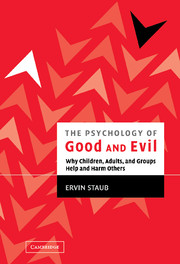Book contents
- Frontmatter
- Contents
- Preface
- Acknowledgments
- PART I INTRODUCTION AND CORE CONCEPTS
- 1 Good and Evil: Themes and Overview
- 2 Studying the Pivotal Role of Bystanders
- 3 Studying and Promoting Altruism and Studying and Working to Prevent Genocide: The Guiding Role of Early Survival
- 4 Is Evil a Useful Concept for Psychologists and Others?
- 5 Basic Human Needs and Their Role in Altruism and Aggression
- PART II THE ROOTS OF HELPING OTHER PEOPLE IN NEED IN CONTRAST TO PASSIVITY
- PART III HOW CHILDREN BECOME CARING AND HELPFUL RATHER THAN HOSTILE AND AGGRESSIVE
- PART IV THE ORIGINS OF GENOCIDE, MASS KILLING, AND OTHER COLLECTIVE VIOLENCE
- PART V THE AFTERMATH OF MASS VIOLENCE: TRAUMA, HEALING, PREVENTION, AND RECONCILIATION
- PART VI CREATING CARING, MORALLY INCLUSIVE, PEACEFUL SOCIETIES
- Appendix: What Are Your Values and Goals?
- Index
- References
3 - Studying and Promoting Altruism and Studying and Working to Prevent Genocide: The Guiding Role of Early Survival
Published online by Cambridge University Press: 07 May 2010
- Frontmatter
- Contents
- Preface
- Acknowledgments
- PART I INTRODUCTION AND CORE CONCEPTS
- 1 Good and Evil: Themes and Overview
- 2 Studying the Pivotal Role of Bystanders
- 3 Studying and Promoting Altruism and Studying and Working to Prevent Genocide: The Guiding Role of Early Survival
- 4 Is Evil a Useful Concept for Psychologists and Others?
- 5 Basic Human Needs and Their Role in Altruism and Aggression
- PART II THE ROOTS OF HELPING OTHER PEOPLE IN NEED IN CONTRAST TO PASSIVITY
- PART III HOW CHILDREN BECOME CARING AND HELPFUL RATHER THAN HOSTILE AND AGGRESSIVE
- PART IV THE ORIGINS OF GENOCIDE, MASS KILLING, AND OTHER COLLECTIVE VIOLENCE
- PART V THE AFTERMATH OF MASS VIOLENCE: TRAUMA, HEALING, PREVENTION, AND RECONCILIATION
- PART VI CREATING CARING, MORALLY INCLUSIVE, PEACEFUL SOCIETIES
- Appendix: What Are Your Values and Goals?
- Index
- References
Summary
introduction
The connection between much of my work and my Holocaust experience is quite obvious. My work was probably also affected by my post-Holocaust experience of living under a communist system in Hungary, escaping from Hungary without my family, living in Vienna, then coming to the United States alone.
I did some early work on fear, control and lack of control, and the use of information and control to reduce fear. At the time, in no way did I connect this work to my own life experiences. I have spent most of my career studying what leads people to help others, what leads them to remain passive in the face of others' need, what leads them to harm others. The latter included the study of the origins of genocide and other collective violence. Underlying all my work has been an interest in change: How can we develop caring in children? How can people become more helpful? How can we reduce youth violence? How can we eliminate violence by groups against innocent people? A thread through all my work has been the study of the passivity and the potential power of bystanders, of individuals and groups who witness suffering or harm inflicted on others.
While the connection of this work to my Holocaust experience is quite clear, for many years I ignored and disregarded this connection, almost denied it. I survived the Holocaust and I was involved with my work, and I emotionally separated these two domains.
- Type
- Chapter
- Information
- The Psychology of Good and EvilWhy Children, Adults, and Groups Help and Harm Others, pp. 31 - 46Publisher: Cambridge University PressPrint publication year: 2003



